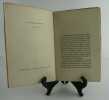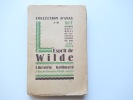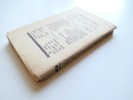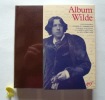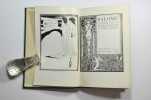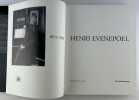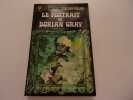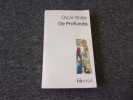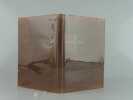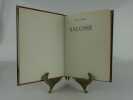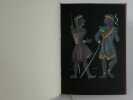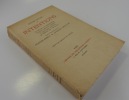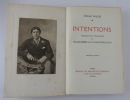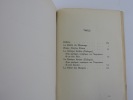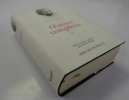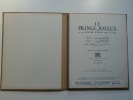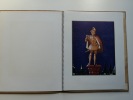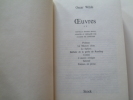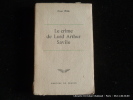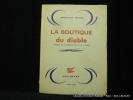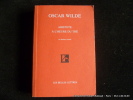1172 books for « wilde h »Edit
-
Type
Book (1170)
Magazine (1)
Music sheets (1)
-
Latest
Last 24h (1)
Last 3 days (6)
Last month (10)
Last week (4)
-
Language
Dutch (8)
English (4)
French (1154)
Greek (1)
Russian (5)
-
Century
19th (16)
20th (606)
21st (67)
-
Countries
Belgium (149)
Brazil (2)
Canada (6)
Côte d'Ivoire (2)
Denmark (12)
France (897)
Germany (3)
Greece (1)
Italy (4)
Spain (1)
Switzerland (87)
United Kingdom (2)
United States of America (6)
-
Syndicate
ALAC (3)
CLAM (10)
CNE (1)
ILAB (503)
NVVA (7)
SLACES (7)
SLAM (451)
Topics
- 1900 (3)
- Agriculture (4)
- Antwerp (3)
- Architecture (8)
- Autographs (4)
- Bible (2)
- Boullaire jacques (4)
- Camus albert (6)
- Cap (2)
- Carpenter (8)
- Chemistry (4)
- Children’s books (19)
- Christmas (3)
- Colette (2)
- Comic strip (2)
- Crime (2)
- Dance & ballet (2)
- Daragnes (3)
- Dedication (3)
- Dignimont (3)
- Discovery (2)
- Drawings (3)
- Economics (2)
- Essays (3)
- Etchings (3)
- Ethnology (2)
- Exegesis (2)
- Exhibition (3)
- Fantastic (5)
- Fine arts (5)
- First edition (13)
- Flemish (2)
- Geography (3)
- Goethe johann wolfgang (2)
- Gold (2)
- Head edition (4)
- Healthcare (4)
- History (13)
- Hitler (3)
- Homosexuality (7)
- Iconography (3)
- Illustrated books (17)
- Industrial arts & crafts - fine arts (2)
- Jazz (3)
- Job (2)
- Job (2)
- Language (3)
- Law (2)
- Literature (7)
- Manuscripts (2)
- Merlin (12)
- Modern comic (7)
- Montgomery (3)
- Museums (2)
- Nazism (2)
- Newspapers press (4)
- Opera ballet (3)
- Painters (2)
- Painting (4)
- Paris (4)
- Perrault charles (2)
- Photography (5)
- Physics (5)
- Pléiade & album de la (2)
- Psychology (2)
- Review (6)
- Reviews (2)
- School (3)
- Sciences (8)
- Socialism (2)
- Sociology (2)
- Tales (9)
- Tea (4)
- Technology (2)
- Theatre (15)
- Theology (3)
- United states (2)
- Wairy louis-constant alias constant (2)
- Wallonia (2)
- War (5)
- Wilde oscar (1098)
- Youth (8)
Opinions de Littérature et d'Art
Paris, L'Edition Moderne - Librairie Ambert, -1913, Broché, 312 pages. Portrait en frontispice et fac-similé d'une lettre d'O. Wilde. Exemplaire solide. TABLE DES MATIÈRES I La Décadence du Mensonge, dialogue. II Plume, Pinceau et Poison, étude de vert . III De la Critique considérée comme un art, avec quelques remarques sur l'importance de ne rien faire, dialogue . IV De la Critique considérée comme un art, avec quelques remarques sur l'importance de discuter toute chose, dialogue . V L'Ame humaine et le Socialisme.
Opinions de Littérature et d'Art. Traduit de l'anglais par J. Cantel.
Paris, L'Edition Moderne. Librairie Lambert, sans date, in-12, broché, couverture légèrement défraîchie, 312p. Portrait photographique de l'auteur en frontispice et fac-similé d'une lettre d'O. Wilde.TABLE DES MATIÈRES I La Décadence du Mensonge, dialogue. II Plume, Pinceau et Poison, étude de vert . III De la Critique considérée comme un art, avec quelques remarques sur l'importance de ne rien faire, dialogue . IV De la Critique considérée comme un art, avec quelques remarques sur l'importance de discuter toute chose, dialogue . V L'Ame humaine et le Socialisme.
De Profundis, précédé de lettres écrites de la prison par Oscar Wilde à Robert Ross, suivi de La Ballade de la Geôle de Reading. Traduits par Henry-D. Davray.
Paris, Mercure de France, sans date, in-8, broché, , 187 pages. Bel exemplaire. Mention de 17ème édition. Exemplaire numéroté 16389.
Oscar Wilde. Collection d'Anas sous la direction de Léon Treich
Reference : 5451
(1926)
Oscar WILDE. GATTEGNO Jean & HOLLAND Merlin
Reference : 76942
(1996)
ISBN : 9782070113347
Album Oscar WILDE
Paris, Gallimard NRF Bibliothèque De La Pléiade, 1996, 180x110mm, reliure éditeur sous rhodoïd et étui, 266pp. 267 illustrations. Parfait état.
The Sphinx.
London : Privately printed, 1901 In-4, (2)-32 feuillets. Cartonnage de l'éditeur, jaquette imprimée (un peu passée).
L'un de 300 exemplaires, le nôtre n° 247 sur "antique paper". Le poème est imprimé au recto des feuillets, le verso illustré alternativement par une tête de sphinx ou un Christ en croix. Edition limitée d'un poème méconnu de Wilde. La production poétique d’Oscar Wilde a été presqu’entièrement éclipsée par l'attention considérable portée à ses drames, à son roman Le Portrait de Dorian Gray et à ses contes. Ses essais eux-mêmes ont davantage stimulé la recherche universitaire que sa poésie érudite et chargée de mythologie, et en particulier, son obscur poème Le Sphinx.Le sphinx, comme le vampire et d’autres créatures chimériques, compte parmi les motifs récurrents de la littérature et de l'art du XIXe siècle, inventés pour transgresser les conceptions victoriennes de la raison et du décorum. Ce poème de Wilde mérite de se voir accorder une place nettement plus importante, si ce n'est une position clé, dans l'œuvre de l'écrivain. Le poème, agrémenté d’illustrations art-nouveau de Charles Ricketts et d’une dédicace au poète symboliste français Marcel Schwob, fut publié en 1894, tout juste un an avant la chute du dandy Wilde. Le tirage très restreint de l’ouvrage souligne que Wilde le concevait comme un joyau littéraire destiné à d’heureux privilégiés et non aux yeux vulgaires, volonté que respecte l’édition limitée de 1901. Ce poème présente des affinités frappantes avec "Le Corbeau" de Poe : tous deux prennent la forme du monologue d'un étudiant hypersensible, soudain exposé à l'irruption du fantastique et de l’étrange dans son monde clos. Mais alors que le personnage de Poe dans "Le Corbeau" est essentiellement préoccupé par des questions d’ordre métaphysique, celui de Wilde se trouve confronté au sphinx comme un défi sexuel immobile et silencieux. Le sphinx, symbole de la beauté parfaite et de l’éternelle jeunesse, permet au poète d’annuler les distances temporelles et de fusionner, dans un même corps fantasmé, la femme et l'animal.Voir l'article de Norbert Lennartz, Oscar Wilde's "The Sphinx" -- a dramatic monologue of the dandy as a young man ?, 2004.
On a Property of the Magneto-Electric Current to Control and Render Synchronous the Rotations of the Armatures of a Number of Electromagnetic Induction Machines.
[No place], 1869. 8vo. In the original printed wrappers, no backstrip. Offprint from the ""Philosophical Magazine"", January 1869. With authors presentation inscription to front wrapper: ""With the author's Compliments."". Fine and clean. 9 pp.
Offprint issue with author's presentation insciption to front wrapper of Wilde's paper on how to control and render the magneto-electri current which nearly led to the discovery of the principle of self-excitation. This was, however, achieved by other inventors first, notably Charles Wheatstone and the Siemens brothers.""In 1856 Wilde established a business in Manchester as an electric-telegraph and lightning-conductor engineer, and spent some years on the development of a magneto-electric alphabetic telegraph, which was demonstrated at the international exhibition in London in 1862. In December 1863 he patented a twin-armature machine in which a magneto-electric generator provided excitation current for the field winding of another generator. These machines were made in quantity by Wilde & Co., but in use they had the disadvantage of becoming very hot. In 1867 [Described in the present paper]. he patented an entirely different type of multipolar machine, which was used for electro-deposition and arc lighting. Among his other patents was one in 1875 for the making of copper rollers for calico printing."". (Oxford DNB). Henry Wilde (1833 - 1919) was a wealthy individual from Manchester, England who used his self-made fortune to indulge his interest in electrical engineering. He invented the dynamo-electric machine, or self-energising dynamo, an invention for which Werner von Siemens is more usually credited and, in fact, discovered independently. At any rate, Wilde was the first to publish, his paper was communicated to the Royal Society by Michael Faraday in 1866. The self-energising dynamo replaces the permanent magnets of previous designs with electro-magnets and in so doing achieved an enormous increase in power. The machine was considered remarkable at the time, especially since Wilde was fond of spectacular demonstrations, such as the ability of his machine to cause iron bars to melt.
Salome ; A Tragedy in One Act Translated from the French of Oscar Wilde with Sixteen Drawings By Aubrey Beardsley
John Lane, London, 1912 XXIII, 82 pp In12, dans un beau cartonnage d’origine vert et doré, dos plat, non ébarbé, tranche de tête dorée, rare édition anglaise, enrichie de nombreuses illustrations dans un symbolisme décadent par Aubrey Beardsley.
Salomé fut écrit pour la première fois en français et publié pour la première fois en France en 1893, la première traduction anglaise parut en 1894 traduite par Lord Alfred Douglas et illustré par Aubray Beardsley.Bien que sur la première page Oscar Wilde indique comme traducteur Lord Alfred Douglas, il semble acquis qu'il en soit lui même l'auteur, s'étant simplement appuyé sur les travaux de son ami. En 1895, à la suite d'un procès retentissant, Wilde est condamné à deux ans de travaux forcé et emprisonné le soir même pour homosexualité. La première représentation de Salomé, eu lieu a paris, en 1896, au "Théatre de l'oeuvre" alors que Wilde était incarcéré à la fameuse geôle "Reading". L'interdiction de la pièce fut effective pendant 40 ans, et mis à part deux représentations privées elle ne fut produite publiquement que le 5 octobre 1931. Ceci explique que toutes les éditions anglo-saxonnes de Salomé soient rares et difficile à rencontrer en bel état.
Lettres d'Oscar Wilde. Choix et avant-propos de Rupert Hart-Davis. Traduit de l'anglais par Henriette de Boissard. Préface de Diane de Margerie.
Paris: Gallimard, 1994 in-8, 552 pages. Broché, état d'usage, premier plat de couv. un peu froissé, marque de bic sur la page de garde, assez bon état.
Lettres d'Oscar Wilde. Choix et avant-propos de Rupert Hart-Davis. Traduit de l'anglais par Henriette de Boissard. Préface de Diane de Margerie. (Paris: Gallimard, 1994) [M.C.: Angleterre, littérature, Oscar Wilde]
On the Origin of Elementary Substances, and on some New Relations of their Atomic Weights. - [WILDE ON THE ORIGIN OF ELEMENTS]
Manchester, T. Sowler and Co., 1878. 8vo. In the original printed wrappers. Offprint from ""The Proceedings of the Manchester Literary and Philosophical Society"", April 30. Author's presentation inscription to front wrapper ""Edmund J Mills / with the Author's Compliments"". Miscolouring to lower part of front wrapper. Internally fine and clean. 25 pp. + 1 folded plate.
Scarce offprint issue, with author's presentation inscription, of Wilde's contribution to the origin of elements and his views on the newly created periodic system.Henry Wilde (1833 - 1919) a wealthy individual from Manchester, England who used his self-made fortune to indulge his interest in electrical engineering. He invented the dynamo-electric machine, or self-energising dynamo, published in 1866. The machine was considered remarkable at the time, especially since Wilde was fond of spectacular demonstrations, such as the ability of his machine to cause iron bars to melt.
On the Origin of Elementary Substances and on some New Relations of Their Atomic Weights (+) Sur l'origine corps simples, et sur l'existence de relations nouvelles entre leurs poids atomiques.
London (+) Paris, Kegan Paul (+) Gauthier-Villars et fils, 1892. Large4to. Without front wrapper and backtrip. Internally fine and clean. VI, 18 pp + 1 folded plate.
Second issue, with alterations and additional material, of Wilde's contribution to the origin of elements and his views on the newly created periodic system, including the first French translation. Wilde states in the preface [printed here for the first time] that: ""The reprinting of this paper is all the more desirable, as some of the views set forth therein have been modified by subsequent investigatiors, without advancing much beyond what had already been accomplished"" while, in other instances, there has been a distinct retrogression from the solid position which chemical philosophy had attained more than forty years ago."" Henry Wilde (1833 - 1919) a wealthy individual from Manchester, England who used his self-made fortune to indulge his interest in electrical engineering. He invented the dynamo-electric machine, or self-energising dynamo, published in 1866. The machine was considered remarkable at the time, especially since Wilde was fond of spectacular demonstrations, such as the ability of his machine to cause iron bars to melt.
Oscar Wilde avec une introduction de Rupert Hart-Davis
traduit de l'anglais par Henriette de BoissardLettres d'Oscar Wilde - tome I et tome II - Ed. nrf. Gallimard - coll. Du Monde Entier, 2 vol. in-8 broché - 1966 - 584 pages + 686 pages - Ed. nrf. Gallimard ,parfait etat
Ray A6*
SALOME- A TRAGEDY IN ONE ACT
John Lane, The Bodley Head, London 1911 - 66pp; A Tragedy in One Act Translated From The French of Oscar Wilde;Covers ,Aubrey Beardsley illustration to front board.
WILDE, OSCAR Aubrey Beardsley Remise de 20% pour toutes commandes égales ou supérieures à 100 €
The Ballad of Reading Gaol
New-York, Barso & Hopkins, undated (1898), in-12 (10,5x17,5cm), soft leather cover, 30p. Some marginal tears without missing paper.
Henri EVENEPOEL 1872-1899.
Paris Snoeck-Ducaju & ZoonCrédit Communal, 1994, fort in-4, relié sous jaquette éditeur, 375p. Ouvrage publié à l'occasion de l'exposition Henri Evenepoel présentée aux Musées Royaux des Beaux-Arts de Belgique, Bruxelles du 17 mars au 12 juin 1994. Très bon état.
LE PORTRAIT DE DORIAN GRAY
petit format, couverture souple. 282 pages. Papier jauni 1975 marabout
DE PROFONDIS
Format d'un livre de poche. Couverture souple. 285 pages. Bon état 2005 Folio essais
Salomé. Avec des illustrations au pochoir d'après des gouaches de Derain.
Monte-Carlo, Les Fermiers Généraux, Editions du Cap, 1956, in-8, pleine toile rose éditeur, sous rodhoïd, 525 pages. Bon état. Un des 6000ex. h.-c. numérotés.
INTENTIONS. Le déclin du mensonge, plume, crayon, poison, le critique artiste, la vérité des masques. Traduction de Hughes Rebell & Charles Grolleau
Paris, Librairies des Bibliophiles Parisiens, 1923, in-12, broché ,sous couverture rempliée, 244 pages Bon état. Portrait de l'auteur en frontispice présentant quelques rousseurs.
Oeuvres Complètes. Edition établie et préfacée par Alain Delahaye. Tome 1: Fiction - Théâtre - Canevas et Projets. Notes, Bbliographie, Iconographie, Filmographie
Paris, Mercure de France, 1992, 12x18cm, relié, jaquette éditeur, 2035p. Très bon état.
Le Prince Joyeux. Le livre sonore et parlant
Paris, TPL / Nicholas Sandor , 1948, in-4, reliure spirale sous couverture cartonnée illustrée, Illustré par H. Paul de 16 planches couleurs à pleine page. Interprétation de Jean Weber de la Comédie Française. Musique de Leslie Bridgewater. Adapté par Minnie Lake. Traduction de Thérèse d'Andigné. Exemplaire en très bon état tant pour le livre que pour le disque.
Oeuvres** Poèmes. La Maison close. Le Sphinx. Ballade de la geôle de Reading. Contes. L'oeuvre critique. Salomé. Poèmes en prose.
Paris, Stock, 1977, in-8, relié jaquette éditeur, 525 pages. Bon état.
Le crime de Lord Arthur Savile et autres contes
Paris, Mercure de France, 1963, broché, 224 pages. Petit accroc en pied. Bon exemplaire.
La boutique du diable.
Paris, Gallimard, 1937, Broché., 268 pages. Dos très légèrement insolé, sinon exemplaire en bon état.
Aristote à l'heure du thé et autres essais
Paris, Les Belles Lettres, 1994, in-8, Broché., 294 pages. Plis au dos. Exemplaire légèrement gauchi.
 Write to the booksellers
Write to the booksellers


